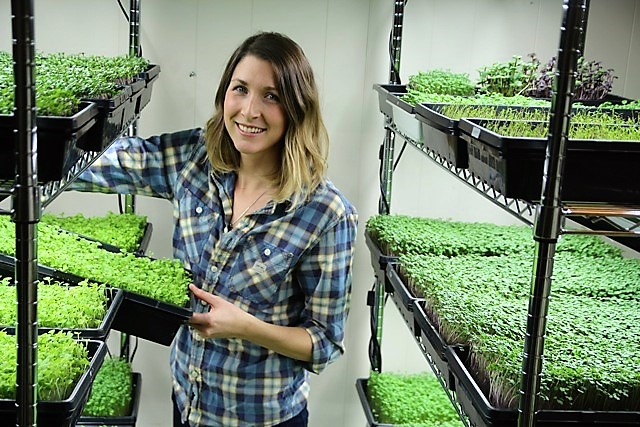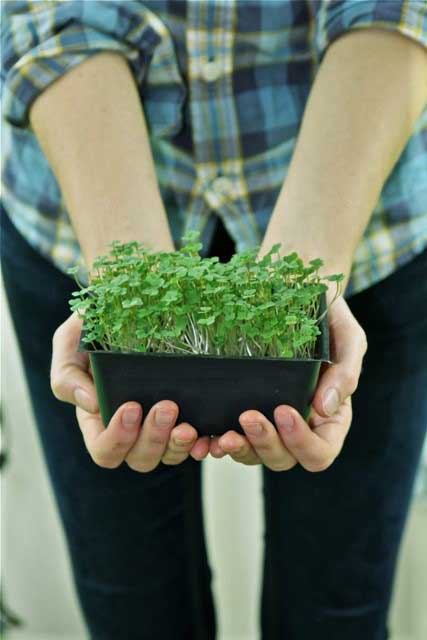Urban Farms: The New Frontier for Female Farmers
Does the city represent a new landscape for women accessing land to grow food?
Urban Farms: The New Frontier for Female Farmers
Does the city represent a new landscape for women accessing land to grow food?

Studies prove that increasing numbers of women are getting into farming in North America. But while more women are pitching in on the farm, the old Farmer Joe stereotype still has a grip on the reins of rural food production. The statistics don’t lie: Fewer women own farmland than men. It’s estimated that only 27 percent of farm operators in Canada are women. Numbers are even lower in the U.S., with a mere 14 percent of farms headed by women. What’s causing the major gender imbalance in agriculture today?
We could blame history, which has largely defined who drives the tractor in society. More than a century ago, European farmers settled in North America and dropped seed into the soil, raising their sons into farmers and their daughters into “farmer’s wives.” Culture maintained the practice of transferring land and farming knowledge from father to son, while women accessed land through their husbands. Women’s efforts on family farms around food – growing, preserving, preparing, and distributing – are often celebrated in history. But rarely do we talk about how the tradition of inheritance plays a part in the small percentage of women who own farmland today.
Rarely do we talk about how the tradition of inheritance plays a part in the small percentage of women who own farmland today.
For one, it’s never been more expensive for aspiring female farmers to secure land. (Or, really, all farmers.) In Canada, the value of land increased by 113 percent from 2000 to 2012, while in the U.S., the cost of farmland in Iowa jumped 31 percent in a single year alone. In 2015, the United States farm real estate value, a measurement of the value of all land and buildings on farms, averaged $3,020 per acre.
“I don’t think I’ve ever considered owning farmland,” admits Hanel.
Instead of facing the improbability of purchasing land and equipment necessary to farm – which can cost upwards of $1.5 million dollars – the solution for the young urbanite, like Hanel, could be looking within the city – or even in her own home. In early 2015, Hanel started up Micro YYC, an urban farming and micro greens operation in Calgary. She bypassed the barrier of accessing land altogether by “farming” in her basement, investing only $3,000 in industry shelves, grow lights, seed trays, and seeds. “Compared to buying land and things like farm machinery, it was peanuts,” says Hanel. “When I ventured into [farming] on my own, focusing on micro greens just seemed like the most doable thing – no buying, no borrowing, no rent, no weather issues, and I could start right away in the middle of winter.”

Hanel’s approach to farming in the city has paid off. Moving into her third year as a grower and business owner, her creativity and entrepreneurship has already turned a profit.
Plus, Hanel’s trying to shake up micro-green production in Calgary, forgoing growing the common alfalfa and pea shoots to experiment with niche varieties like basil, chervil, kale, red cabbage, and mustard greens. She tends the shoots from home, watering, weeding, and trouble-shooting against mold, and packages her harvest into spicy and mild mixes for weekly sale at the Gull Valley Greenhouse’s booth at the Calgary Farmers’ Market. With more than 10,000 people frequenting the market every week, she’s able to sell around 200 units and gross $500 to $800 a week. Hanel is also cultivating relationships with local chefs. Her basil shoots are featured in an exquisite tomato salad at Taste, a trendy kitchen and lounge in Calgary.
Hanel isn’t deterred by gender dynamics. She’s forging ahead, carving out new possibilities for women to break barriers of accessing land to grow food in the city.
Overall, statistical analysis of the numbers of female urban farm operators in North America is still lacking. But a recent article by The New York Times that interviewed 19 urban farms in New York City reported that 15 of those farms – nearly 80 percent – were led by women. To date, Hanel is one of the only female farmers running her own operation in Calgary, though she hopes it’s just the beginning for other women to follow her lead.
“Even though I am outnumbered by my male peers, I have experienced kindness and support from others in the field, even my competitors,” says Hanel. “This is one of the great things about being involved in a food movement. Having shared values means that, on some level, we are all working together. Urban farming isn’t easy, but if you have the drive to do it, there’s so much opportunity to succeed – and you don’t need to own land to do it.”
While the city offers alternatives to the conventional farm model, the more insidious gender stereotyping about “who can farm” still remains rooted in societal attitudes. But Hanel isn’t deterred by gender dynamics. She’s forging ahead, carving out new possibilities for women to break barriers of accessing land to grow food in the city.
“There will always be people, not necessarily only men, who will question what I could possibly know about growing food, or owning a business,” says Hanel. “But I feel confident to say that I’m doing it successfully.”
Follow us

This work is licensed under a Creative Commons Attribution-NoDerivatives 4.0 International License.
Want to republish a Modern Farmer story?
We are happy for Modern Farmer stories to be shared, and encourage you to republish our articles for your audience. When doing so, we ask that you follow these guidelines:
Please credit us and our writers
For the author byline, please use “Author Name, Modern Farmer.” At the top of our stories, if on the web, please include this text and link: “This story was originally published by Modern Farmer.”
Please make sure to include a link back to either our home page or the article URL.
At the bottom of the story, please include the following text:
“Modern Farmer is a nonprofit initiative dedicated to raising awareness and catalyzing action at the intersection of food, agriculture, and society. Read more at <link>Modern Farmer</link>.”
Use our widget
We’d like to be able to track our stories, so we ask that if you republish our content, you do so using our widget (located on the left hand side of the article). The HTML code has a built-in tracker that tells us the data and domain where the story was published, as well as view counts.
Check the image requirements
It’s your responsibility to confirm you're licensed to republish images in our articles. Some images, such as those from commercial providers, don't allow their images to be republished without permission or payment. Copyright terms are generally listed in the image caption and attribution. You are welcome to omit our images or substitute with your own. Charts and interactive graphics follow the same rules.
Don’t change too much. Or, ask us first.
Articles must be republished in their entirety. It’s okay to change references to time (“today” to “yesterday”) or location (“Iowa City, IA” to “here”). But please keep everything else the same.
If you feel strongly that a more material edit needs to be made, get in touch with us at [email protected]. We’re happy to discuss it with the original author, but we must have prior approval for changes before publication.
Special cases
Extracts. You may run the first few lines or paragraphs of the article and then say: “Read the full article at Modern Farmer” with a link back to the original article.
Quotes. You may quote authors provided you include a link back to the article URL.
Translations. These require writer approval. To inquire about translation of a Modern Farmer article, contact us at [email protected]
Signed consent / copyright release forms. These are not required, provided you are following these guidelines.
Print. Articles can be republished in print under these same rules, with the exception that you do not need to include the links.
Tag us
When sharing the story on social media, please tag us using the following: - Twitter (@ModFarm) - Facebook (@ModernFarmerMedia) - Instagram (@modfarm)
Use our content respectfully
Modern Farmer is a nonprofit and as such we share our content for free and in good faith in order to reach new audiences. Respectfully,
No selling ads against our stories. It’s okay to put our stories on pages with ads.
Don’t republish our material wholesale, or automatically; you need to select stories to be republished individually.
You have no rights to sell, license, syndicate, or otherwise represent yourself as the authorized owner of our material to any third parties. This means that you cannot actively publish or submit our work for syndication to third party platforms or apps like Apple News or Google News. We understand that publishers cannot fully control when certain third parties automatically summarize or crawl content from publishers’ own sites.
Keep in touch
We want to hear from you if you love Modern Farmer content, have a collaboration idea, or anything else to share. As a nonprofit outlet, we work in service of our community and are always open to comments, feedback, and ideas. Contact us at [email protected].by Trina Moyles, Modern Farmer
December 3, 2015
Modern Farmer Weekly
Solutions Hub
Innovations, ideas and inspiration. Actionable solutions for a resilient food system.
ExploreExplore other topics
Share With Us
We want to hear from Modern Farmer readers who have thoughtful commentary, actionable solutions, or helpful ideas to share.
SubmitNecessary cookies are absolutely essential for the website to function properly. This category only includes cookies that ensures basic functionalities and security features of the website. These cookies do not store any personal information.
Any cookies that may not be particularly necessary for the website to function and are used specifically to collect user personal data via analytics, ads, other embedded contents are termed as non-necessary cookies.